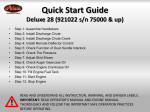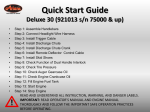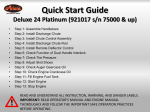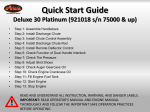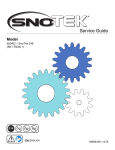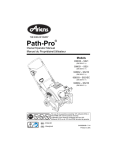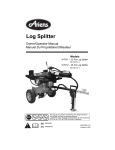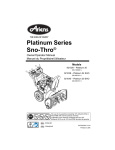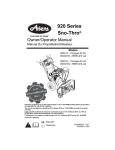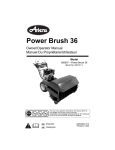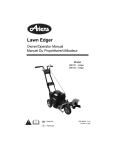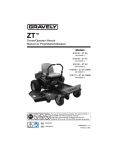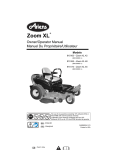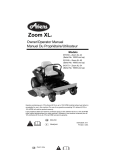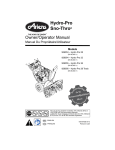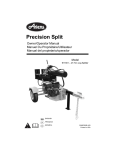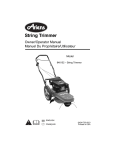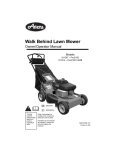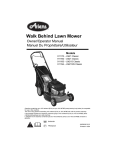Download Ariens 920013 Specifications
Transcript
Compact Series Sno-Thro® Owner/Operator Manual Manuel du Propriétaire/Utilisateur Models 920013 – Compact 22 LE (SN 128000 +) 920021 – Compact 24 LE (SN 086000 +) 920022 – Compact 24 LET (SN 001300 +) E10 The use of any gasoline exceeding 10% ethanol (E10) or 10% MTBE will void the product warranty. L’utilisation d’une essence contenant plus de 10% d’éthanol (E10) ou de 10% de MTBE annulent la garantie. ENGLISH FRANÇAIS 04631900E • 7/14 Printed in USA TABLE OF CONTENTS SAFETY. . . . . . . . . . . . . . . . . . . . . . . . . . 4 STORAGE . . . . . . . . . . . . . . . . . . . . . . . 36 ASSEMBLY . . . . . . . . . . . . . . . . . . . . . . . 8 SERVICE PARTS . . . . . . . . . . . . . . . . . 37 CONTROLS and FEATURES . . . . . . . . 12 ACCESSORIES. . . . . . . . . . . . . . . . . . . 37 OPERATION . . . . . . . . . . . . . . . . . . . . . 15 TROUBLESHOOTING . . . . . . . . . . . . . 37 MAINTENANCE . . . . . . . . . . . . . . . . . . 21 SPECIFICATIONS . . . . . . . . . . . . . . . . . 39 SERVICE AND ADJUSTMENTS . . . . . 26 WARRANTY . . . . . . . . . . . . . . . . . . . . . 40 INTRODUCTION MANUALS Serial Number Label Before operation of unit, carefully and completely read your manuals. If used improperly, this unit could be dangerous and cause personal injury or property damage. The contents will provide you with safety instructions for the safe use of your unit during normal operation and maintenance. All reference to left, right, front, or rear are given from operator standing in operation position and facing the direction of forward travel. ENGINE MANUAL Figure 1 The engine on this unit is covered by a separate manual specific to the engine. This manual is included in the literature package that shipped with the unit. Refer to this manual for engine service recommendations. If the engine manual is not available, contact the engine manufacturer for a replacement manual. • Record unit model and serial numbers here. • Record engine model and serial numbers here. MODEL AND SERIAL NUMBERS When ordering replacement parts or making service inquiries, know the Model and Serial numbers of your unit and engine. Numbers are located on the product registration form in the unit literature package. They are printed on a serial number label, located on the frame of your unit (Figure 1). PRODUCT REGISTRATION The Ariens dealer must register the product at the time of purchase. Registering the product will help the company process warranty claims or contact you with the latest service information. All claims meeting requirements during the limited warranty period will be honored, whether or not the product registration card is returned. Keep a proof of purchase if you do not register your unit. Customer Note: If the dealer does not register your product, please fill out, sign, and return the product registration card to Ariens or go to www.ariens.com. EN - 2 UNAUTHORIZED REPLACEMENT PARTS Use only Ariens replacement parts. The replacement of any part on this vehicle with anything other than an Ariens authorized replacement part may adversely affect the performance, durability, or safety of this unit and may void the warranty. Ariens disclaims liability for any claims or damages, whether warranty, property damage, personal injury or death arising out of the use of unauthorized replacement parts. To locate your nearest Ariens Dealer, go to www.ariens.com on the internet. DISCLAIMER Ariens reserves the right to discontinue, make changes to, and add improvements upon its products at any time without public notice or obligation. The descriptions and specifications contained in this manual were in effect at printing. Equipment described within this manual may be optional. Some illustrations may not be applicable to your unit. DELIVERY Customer Note: If you have purchased this product without complete assembly and instruction by your retailer, it is your responsibility to: 1. Read and understand all assembly instructions in this manual. If you do not understand or have difficulty following the instructions, contact your nearest Ariens Dealer for assistance. Make sure all assembly has been properly completed. NOTICE: To locate your nearest Ariens Dealer, go to www.ariens.com on the Internet. WARNING: Improper assembly or adjustments can cause serious injury. 2. Understand all Safety Precautions provided in the manuals. 3. Review control functions and operation of the unit. Do not operate the Sno-Thro unless all controls function as described in this manual. 4. Review recommended lubrication, maintenance and adjustments. 5. Review Limited Warranty Policy. 6. Fill out a Product Registration Card and return the card to the Ariens Company or go to www.ariens.com. EN - 3 SAFETY WARNING: To avoid injury to hands and feet, always disengage clutches, shut off engine, and wait for all movement to stop before unclogging or working on snow thrower. Hand contact with the rotating impeller is the most common cause of injury associated with snow throwers. Never use your hand to clean out the discharge chute. Keep hands and feet away from auger and impeller. SAFETY DECALS AND LOCATIONS ALWAYS replace missing or damaged Safety Decals. Refer to Figure 2 for safety decal locations. 1 2 SAFETY ALERTS Look for these symbols to point out important safety precautions. They mean: Attention! Personal Safety Is Involved! Become Alert! Obey The Message! The safety alert symbols above and signal words below are used on decals and in this manual. Read and understand all safety messages. 3 Figure 2 1. DANGER! DANGER: IMMINENTLY HAZARDOUS SITUATION! If not avoided, WILL RESULT in death or serious injury. Danger! WARNING: POTENTIALLY HAZARDOUS SITUATION! If not avoided, COULD RESULT in death or serious injury. CAUTION: POTENTIALLY HAZARDOUS SITUATION! If not avoided, MAY RESULT in minor or moderate injury. It may also be used to alert against unsafe practices. NOTATIONS NOTICE: General reference information for proper operation and maintenance practices. IMPORTANT: Specific procedures or information required to prevent damage to unit or attachment. EN - 4 ONLY use clean-out tool to clear blockages. NEVER use your hands. Never direct discharge towards persons or property that may be injured or damaged by thrown objects. Keep people away from unit while operating. Keep children out of work area and under watchful care of a responsible adult. 3. DANGER! Stop engine, remove key, read manual before making any repairs or adjustments. Danger! Read Owner/Operator Manual. ROTATING PARTS. Keep clear of auger while engine is running. • Read Operator’s Manual. • Allow operation only by properly trained adult, never children. • Stop engine and remove ignition key prior to leaving the operator’s position for any reason. • Keep all controls, guards and safety devices properly serviced and functional. • Never direct discharge towards persons or property that may be injured or damaged by thrown objects. Wear appropriate hearing protection. 2. DANGER! Danger! ROTATING PARTS! ONLY use clean-out tool to clear blockages. NEVER use your hands or feet. High speed impeller rotates below discharge opening. Wait for all moving parts to stop before removing clogs or servicing. SAFETY RULES Read, understand, and follow all safety practices in Owner/Operator Manual before beginning assembly or operating. Failure to follow instructions could result in personal injury and/or damage to unit. ALWAYS remove key and/or wire from spark plug before assembly, maintenance or service. Unintentional engine start up can cause death or serious injury. Complete a wa k around inspection of unit and work area to understand: • Work area • Your unit • All safety decals ALWAYS check overhead and side clearances carefully before operation. ALWAYS be aware of traffic when operating along streets or curbs. Keep children and people away. Keep children out of work area and under watchful care of a responsible adult. NEVER allow children to operate or play on or near unit. Be alert and shut off unit if children enter area. EN - 5 DO NOT allow adults to operate unit without proper training. Only trained adults may operate unit. Training includes actual operation. Keep area of operation clear of all toys, pets, and debris. Thrown objects can cause injury. Check for weak spots on docks, ramps or floors. Avoid uneven work areas and rough terrain. Stay alert for hidden hazards. DO NOT operate near drop-offs, ditches, or embankments. Unit can suddenly turn over if a wheel is over the edge of a cliff or ditch, or if an edge caves in. Falling snow, fog, etc. can reduce vision and cause an accident. Operate unit only when there is good visibility and light. NEVER operate unit after or during the use of medication, drugs or alcohol. Safe operation requires your complete and unimpaired attention at all times. NEVER allow anyone to operate this unit when their alertness or coordination is impaired. DO NOT operate unit without wearing adequate winter outer garments. Wear adequate safety gear, including safety glasses with side shields, and protective gloves. Wear proper footwear to improve footing on slippery surfaces. DO NOT wear loose clothing or jewelry and tie back hair that may get caught in rotating parts. Protect eyes, face and head from objects that may be thrown from unit. Wear appropriate hearing protection. Avoid sharp edges. Sharp edges can cut. Moving parts can cut off fingers or a hand. ALWAYS keep hands and feet away from all rotating parts during operation. Rotating parts can cut off body parts. NEVER place your hands or any part of your body or clothing inside or near any moving part while unit is running. ALWAYS keep hands away from all pinch points. DO NOT touch unit parts which might be hot from operation. Allow parts to cool before attempting to maintain, adjust or service. Never direct discharge towards persons or property that may be injured or damaged by thrown objects. Use extreme caution on gravel surfaces. Stay alert for hidden hazards or traffic. Adjust skid shoes so Scraper Blade does not contact gravel. DO NOT throw snow any higher than necessary. Deflected materials can cause injury and property damage. Always stand clear of the discharge area when operating this unit. Fumes from engine exhaust can cause injury or death. DO NOT run engine in an enclosed area. Always provide good ventilation. ALWAYS disengage attachment, stop unit and engine, remove key and allow moving parts to stop before leaving operator’s position. ROTATING IMPELLER CAN CAUSE SERIOUS INJURY. NEVER ATTEMPT TO UNCLOG OR CLEAN UNIT WHILE ENGINE IS RUNNING. Read, understand, and follow all instructions in the manual and on the machine before starting. Understand: • How to operate all controls. • The functions of all controls. • How to STOP in an emergency. Before starting engine, disengage control(s). Use only approved extension cords and receptacles when starting units equipped with electric starter. DO NOT connect electric starter cord to any wiring system that is not a three-wire grounded system. ALWAYS allow unit and engine to adjust to outdoor temperatures before clearing snow. Always be sure of your footing, especially when operating in reverse or leaving the operator’s position. Walk, never run during operation. DO NOT overload the machine capacity by attempting to operate or to clear snow at too fast a rate. Slow down and turn corners slowly. Do not operate in reverse unless absolutely necessary. ALWAYS back up slowly. Always look down and behind before and while backing. Disengage attachment drive when traveling from one work area to another. Abnormal Vibrations are a warning of trouble. Striking a foreign object can damage unit. Immediately stop unit and engine. Remove key and wait for all moving parts to stop. Remove wire from spark plug. Inspect unit and make any necessary repairs before restart. Before cleaning, removing clogs or making any inspections, repairs, etc.: disengage clutch(es), stop unit and engine, remove key, allow moving parts to stop. Allow hot parts to cool. EN - 6 Run unit a few minutes after clearing snow to prevent freeze-up of attachment. Disengage attachment when not in use. Disengage all clutches before starting engine. Adjust skid shoes to clear gravel or crushed rock surfaces safely. Never leave a running unit unattended. ALWAYS shut off engine before leaving unit. ALWAYS remove key to prevent unauthorized use. Never carry passengers. Check clutch and brake operation frequently. Adjust and service as required. All motion of drive wheels and auger/impeller must stop quickly when control levers are released. DO NOT operate on steep slopes. DO NOT clear snow across the face of slopes. Keep all movement on slopes slow and gradual. DO NOT make sudden changes in speed or direction. Use a slow speed to avoid stops or shifts on slopes. Avoid starting or stopping on a slope. DO NOT park unit on a slope unless absolutely necessary. When parking on a slope always block the wheels. ALWAYS shut off engine, remove key, and close fuel shut-off valve or drain fuel when transporting unit on a truck or trailer. Use extra care when loading or unloading unit onto trailer or truck. Secure unit chassis to transport vehicle. NEVER secure from rods or linkages that could be damaged. DO NOT transport machine while engine is running. Keep unit free of ice or other debris. Clean up oil or fuel spills. This product is equipped with an internal combustion type engine. DO NOT use unit on or near any unimproved, forest-covered or brush covered land unless exhaust system is equipped with a spark arrester meeting applicable local, state or federal laws. A spark arrester, if it is used, must be maintained in effective working order by operator. Fuel is highly flammable and its vapors are explosive. Handle with care. Use only an approved gasoline container with an appropriately sized dispensing spout. NO smoking, NO sparks, NO flames. ALWAYS allow engine to cool before servicing. NEVER fill fuel tank when engine is running or hot from operation. NEVER fill or drain fuel tank indoors. Replace fuel cap securely and clean up spilled fuel. Never fill containers inside a vehicle or on a truck or trailer bed with a plastic liner. Always place containers on the ground away from your vehicle before filling. When practical, remove gas-powered equipment from the truck or trailer and refuel it on the ground. If this is not possible, then refuel such equipment on a trailer with a portable container, rather than from a gasoline dispenser nozzle. Keep the nozzle in contact with the rim of the fuel tank or container opening at all times until fueling is complete. Do not use a nozzle lockopen device. If fuel is spilled on clothing, change clothing immediately. Properly remove fuel before tipping unit up onto housing, so no spills will occur. Secure unit so it will not tip over during maintenance. ALWAYS keep protective structures, guards, and panels in good repair, in place and securely fastened. NEVER modify or remove safety devices. DO NOT change engine governor settings or over-speed engine. Fumes from engine exhaust can cause injury or death. DO NOT run engine in an enclosed area. Always provide good ventilation. ALWAYS maintain unit in safe operating condition. Damaged or worn out muffler can cause fire or explosion. Keep all hardware properly tightened. Check shear bolts frequently. Maintain or replace safety and instruction labels, as necessary. NEVER store unit with fuel in fuel tank, inside a building where any ignition sources are present such as hot water heaters, space heaters, or clothes dryers. Allow the engine to cool before storing in any enclosure. Shut off fuel and allow engine to cool completely before storing in closed area or covering unit. For extended storage, clean unit thoroughly. See Engine Manual for proper storage. Use only attachments or accessories designed for your unit. Check components frequently. If worn or damaged, replace with manufacturer’s recommended parts. EN - 7 ASSEMBLY Unfold Handlebar ASSEMBLY WARNING: AVOID INJURY. Read and understand the entire Safety section before proceeding. WARNING: Dropping or tipping over boxed unit could result in personal injury or damage to unit. (Figure 4) 1. Remove the lower and loosen the upper hardware on the handlebar assembly. 2. Loosen the hardware on the shift rod. 3. Put speed selector lever in the sixth forward position. 4. Rotate the handlebars into operating position. NOTICE: Be careful not to damage cable spring hooks when rotating handlebars upward. 5. Install and tighten all hardware on the handlebar assembly and shift rod. Package Contents 2 4 2 3 1 5 3 1 4 1. 2. 3. 4. 1. 2. 3. 4. 5. Sno-Thro Unit Discharge Chute Chute Crank Literature Pack Figure 4 Figure 3 Tools Required • • • • Shift Rod Handlebar Hardware Shift Rod Hardware Upper Handlebar Assembly Lower Handlebar 6. Adjust speed selector lever as specified in Speed Selector Adjustment on page 28. 7. Adjust attachment cable as specified in Attachment Clutch/Brake Adjustment on page 28. 8. Adjust traction cable as specified in Traction Drive Clutch Adjustment on page 31. Pliers Open-End Wrenches: 3/8, 7/16, 1/2, 9/16" and/or Adjustable Wrench Tire Gauge Torque Wrench (Optional) EN - 8 INSTALL DISCHARGE CHUTE AND DISCHARGE CHUTE CRANK (Figures 5 and 6) 1. Grease underside of discharge chute ring (if not already greased). 2. Remove mounting hardware from auger housing. 3. Install discharge chute over opening in the auger housing. Finger tighten the mounting hardware removed in step 2. NOTICE: Leave discharge chute pedestal loose to help install the chute crank. 8. Orient the chute and pedestal to its most vertical position and tighten pedestal hardware to 14.8 – 31.0 lbf-ft (20 – 42 N•m). 2 1 2 4 4 3 1 3 1. 2. 3. 4. 5. Mounting Holes Discharge Chute Discharge Chute Ring Chute Pedestal Mounting Hardware 1. 2. 3. 4. 5 Chute Crank Support Bracket Pinion Gear Spring Clip Pin Figure 6 Figure 5 4. Remove gear cover from top of chute pedestal. 5. Slide Chute Crank through the nylon bushing in the support bracket under control panel. NOTICE: Be careful not to damage nylon bushing when attaching crank to the control panel. 6. Connect the chute crank to the pinion gear on discharge chute with spring clip pin. 7. Replace gear cover on top of chute pedestal. EN - 9 Install Remote Deflector Cable (Models 920021, 022) 5. Attach cable eye to pin on bottom of deflector control lever. NOTICE: Hold down chute deflector cap, if needed, for more cable slack. 6. Secure cable eye to control lever with bushing and hairpin. 7. Using the wire hook attached to the deflector cable, hook cable to discharge chute crank. 8. Install cable into clip on top of discharge chute pedestal (Figure 8). (Figures 7 and 8) 1. Pull rubber seal cap away from snap fitting (Figure 7). 2 4 3 1 5 6 3 5 7 6 1 1. 2. 3. 4. 5. 6. 7. Remote Deflector Cable Remote Deflector Control Cable Clip Wire Cable Hook Cable Mounting Bracket Cable Support Bracket Gear Cover Figure 8 9. Make sure deflector cable loops above gear cover between cable clip and cable support bracket (Figure 8). 10. Test controls to be sure deflector works properly. NOTICE: If deflector does not follow full range of travel see Remote Discharge Deflector Control Adjustment on page 27. 2 4 1. 2. 3. 4. 5. 6. Mounting Hole Snap Fitting Rubber Seal Cap Hairpin Bushing Cable Eye Figure 7 Check Function of Dual Handle Interlock 2. Install snap fitting into cable bracket’s mounting hole located under the control panel. 3. Position rubber seal cap over the top of snap fitting. 4. Move deflector control lever to rear most position. Without the engine running, press down (engage) both clutch levers. Release attachment clutch lever. Attachment clutch should remain engaged until traction drive clutch lever is released, then both clutches must disengage. If they do not, contact your Dealer for repairs. EN - 10 Check Tire Pressure (Models 920013, 021) Run-in Attachment Belt Check tire pressure and adjust to the pressure listed on tire sidewall. CAUTION: Avoid injury! Explosive separation of tire and rim parts is possible when they are serviced incorrectly: • Do not attempt to mount a tire without the proper equipment and experience to perform the job. • Do not inflate the tires above the recommended pressure. • Do not weld or heat a wheel and tire assembly. Heat can cause an increase in air pressure resulting in an explosion. Welding can structurally weaken or deform the wheel. • Do not stand in front or over the tire assembly when inflating. Use a clipon chuck and extension hose long enough to allow you to stand to one side. Check Track Tension (Model 920022) Check tracking of unit and tension the tracks as required (see Track Tension Adjustment on page 35). Check Auger Gearcase Oil Check oil level in auger gearcase (see Check Auger Gearcase on page 22). Check Engine Crankcase Oil IMPORTANT: The engine may be shipped with oil in crankcase. Refer to Engine Manual for detailed instructions. Fill Engine Fuel Tank Fill fuel tank. DO NOT OVERFILL! See FILLING FUEL TANK on page 18. Check Function Of All Controls Ensure unit runs and performs properly. Refer to OPERATION on page 15. EN - 11 1. Start unit in a well-ventilated area according to Starting and Shut Off on page 19. 2. Engage attachment clutch lever and run attachment for about 15 minutes. 3. Stop unit, wait for all moving parts to stop, and remove spark plug wire. 4. Adjust clutch idler according to Attachment Clutch/Brake Adjustment on page 28. 5. Adjust belt finger, if necessary. See Check Belt Finger Clearance on page 30. CONTROLS AND FEATURES 1 Model 920021 Model 920013 3 2 16 20 4 3 2 1 18 17 4 5 19 6 7 16 12 17 9 15 14 10 8 13 11 Figure 9 1. Attachment Clutch Lever 2. Speed Selector 3. Traction Drive Clutch Lever 4. Discharge Chute Crank 5. Muffler Guard 6. Remote Discharge Chute Deflector (Model 920021) 7. Discharge Chute 8. Impeller 9. Auger 10. Scraper Blade 11. Auger Gearcase 12. Clean-out Tool 13. Skid Shoe(s) 14. Axle Lock Pin 15. Belt Cover 16. Handlebar 17. Headlight 18. Remote Deflector Control (Model 920021) 19. Remote Chute Deflector Cable (Model 920021) 20. Manual Discharge Chute Deflector (Model 920013) EN - 12 Model 920022 3 1 17 2 4 5 18 6 19 15 7 12 16 9 14 10 8 11 13 Figure 10 1. Attachment Clutch Lever 2. Speed Selector 3. Traction Drive Clutch Lever 4. Discharge Chute Crank 5. Muffler Guard 6. Remote Discharge Chute Deflector 7. Discharge Chute 8. Impeller 9. Auger 10. Scraper Blade 11. Auger Gearcase 12. Clean-out Tool 13. Skid Shoe(s) 14. Belt Cover 15. Handlebar 16. Headlight 17. Remote Deflector Control 18. Remote Chute Deflector Cable 19. Height Adjust Trigger EN - 13 4 6 3 5 1 4 8 7 9 5 Figure 11 1. Gas Tank and Cap 2. Oil Fill and Dipstick 3. Fuel Shut-off Valve 4. Recoil Starter Handle 5. Electric Starter 6. Choke 7. Ignition Switch 8. Primer Bulb 9. Oil Drain Plug EN - 14 2 OPERATION WARNING: AVOID INJURY. Read and understand the entire Safety section before proceeding. WARNING: To avoid injury to hands and feet, always disengage clutches, shut off engine, and wait for all movement to stop before unclogging or working on snow thrower. Keep hands and feet away from auger and impeller. IMPORTANT: If the belt squeals continuously when the attachment clutch lever is engaged, the impeller may be frozen in the auger housing. Immediately release the attachment clutch lever and move the unit into a heated area to thaw. NOTICE: If belt squeals continuously when impeller turns freely, see Attachment Clutch/Brake Adjustment on page 28. Ignition Switch 1 2 CONTROLS AND FEATURES See Figures 9 – 11 for all Controls and Features locations. Dual Handle Interlock When Attachment Clutch and then Traction Drive Clutch are engaged, the Attachment Clutch will remain engaged (lever down) if released. To stop attachment, release Traction Drive Clutch and both clutches will disengage. Operate the ignition switch with the removable key. To start the engine, turn the key to Start (1). To stop the engine, turn the key to Off (2). Primer Bulb Traction Drive Clutch – Left Hand Lever Squeeze the Traction Drive Clutch Lever 2 against the Handlebar (1) to engage wheel drive for propelling unit. Forward speed will vary according 1 to snow depth and moisture content. Release lever (2) to stop movement. NOTICE: When traveling to or from the area to be cleared, press down on the handlebars enough to raise the front of the unit slightly off the surface. Engage the traction drive clutch without engaging the attachment clutch. Pushing the primer bulb in adds fuel for easier engine start. Refer to Starting and Shut Off on page 19. Speed Selector Position the Speed Selector in the appropriate speed notch to control forward and reverse travel. 6 1 1 2 Forward: (6) Fastest (1) Slowest Attachment Clutch – Right Hand Lever 2 1 Squeeze Attachment Clutch Lever against handlebar (1) to engage attachment. Release both clutch levers (2) to disengage power and apply brake to attachment. Reverse: (1) Slow (2) Fast IMPORTANT: DO NOT change motion from forward to reverse with clutch engaged. Forward speed can be changed without declutching. EN - 15 Fuel Shut-Off Valve IMPORTANT: The fuel shut-off valve MUST be in the closed position prior to transporting the unit. The fuel shut-off valve has two positions: OFF Open (1): Use this 2 position to run the unit. 1 ON 1 Closed (2): Use this position to service, transport, or store the unit. Choke Control 1. Choke Closed position: chokes off air to engine 1 for easier start. 2. Choke Open position: allows for normal operation. IMPORTANT: Gradually open choke after engine starts. 2 RUN START Electric Starter The electric starter will start a properly choked and cranked engine when the starter button is pushed. Refer to Starting and Shut Off on page 19. Recoil Starter Handle When pulled, recoil starter handle will turn engine over. IMPORTANT: DO NOT let recoil starter handle snap back against starter. See Starting and Shut Off on page 19. 1. Snow Clean-Out Tool Figure 12 To clear the discharge chute: 1. Shut off engine, remove key, disconnect spark plug wire from spark plug. 2. Wait for impeller blades to stop rotating completely. 3. Remove the snow clean-out tool (1) from the auger housing and use it to remove the clog from the discharge chute. 4. Replace the snow clean-out tool on the auger housing. 5. Reconnect spark plug wire, and restart engine. Manual Discharge Chute Deflector (Model 920013) Snow Clean-Out Tool (Figure 12) WARNING: Hand contact with the rotating impeller is the most common cause of injury associated with snow throwers. Never use your hand to clean out the discharge chute. ALWAYS position discharge chute deflector at a safe angle before starting engine. DO NOT throw snow any higher than necessary. Push deflector handle forward or down to throw snow lower. Pull deflector handle up or to the rear to throw snow higher. IMPORTANT: If Chute Deflector does not stay in set position, adjust as directed in SERVICE AND ADJUSTMENTS on page 26, or repair before operation. Remote Discharge Chute Deflector Control (Models 920021, 022) ALWAYS position discharge chute deflector at a safe angle before starting engine. DO NOT throw snow any higher than necessary. EN - 16 Place deflector remote in a forward notch to throw snow lower. Place deflector remote in a rearward notch to throw snow higher. IMPORTANT: If Chute Deflector does not stay in set position, adjust as directed in SERVICE AND ADJUSTMENTS on page 26, or repair before operation. Wheel Unlocked Discharge Chute Discharge chute rotates 205°. ALWAYS position discharge chute in safe direction and angle, away from operator and bystanders, before starting engine. 1 Discharge Chute Crank Wheel Locked IMPORTANT: If chute does not stay in set position, adjust as directed in SERVICE AND ADJUSTMENTS on page 26, or repair before operation. Rotate the chute with the discharge chute crank handle. IMPORTANT: DO NOT force frozen chute controls. If frozen, take to warm place until controls are free. Axle Lock Pin (Models 920013, 021) 1. Axle Lock Pin (Figure 13) Use the axle lock pin to lock or unlock the right or left wheel. Lock both wheels to increase traction; unlock one wheel to allow for easier turning of the unit. NOTICE: Unit will not drive with both wheels unlocked. Figure 13 Track Angle (Model 920022) The track angle can be adjusted to position the auger housing for level clearing, deep cutting, or transport. 1. Squeeze the handlebar trigger and press down on the handlebars to move the auger housing into an up position. Release the trigger to hold the position. 2. Squeeze the handlebar trigger and lift up on the handlebars to move the auger housing into a down position. Release the trigger to hold the position. EN - 17 GASOLINE Normal Up Position (Transport) Down Position Figure 14 Scraper Blade The scraper blade allows the back of the housing to keep better contact with the surface being cleared. It also prevents damage to the housing from wear. IMPORTANT: DO NOT allow Scraper Blade to wear too far or Auger/Impeller housing will become damaged. Skid Shoes The skid shoes control the distance between the scraper blade and the ground. Adjust skid shoes equally to keep blade level with the ground. Refer to Pre-Start on page 19 for recommended settings. FILLING FUEL TANK WARNING: AVOID INJURY. Read and understand the entire Safety section before proceeding. IMPORTANT: ALWAYS use gasoline that meets the following guidelines: • Clean, fresh gasoline. • A minimum of 87 octane/87 AKI (91 RON). High altitude use may require a different octane. Consult your engine manual. • Gasoline with up to 10% ethanol (gasohol) or up to 10% MTBE (methyl tertiary butyl ether) is acceptable. • Use of any gasoline other than those approved above will void the engine warranty. If the pumps are not marked for the content of alcohol or ethers, check ethanol and MTBE levels with the fuel supplier. • Do not modify the fuel system to use different fuels. • Never mix oil and gasoline. NOTICE: All gasoline is not the same. If the engine experiences starting or performance problems after using a new gasoline, switch to a different fuel provider or fuel brand. IMPORTANT: Excessively oxygenated or reformulated fuels (fuels blended with alcohols or ethers) can damage the fuel system or cause performance problems. If any undesirable operating problems occur, use a gasoline with a lower percentage of alcohol or ether. Add Fuel Stabilizer to Extend Fuel Storage Life IMPORTANT: Fuel stabilizer is recommended for extended storage. See Fuel System on page 36. Add fuel to fuel tank: 1. ALWAYS place unit in open or wellventilated area. 2. Stop engine and allow to cool. 3. Clean Fuel Cap and surrounding area to prevent dirt from entering Fuel Tank. 4. Remove fuel cap. IMPORTANT: Refer to Engine Manual for correct type and grade of fuel. 5. Fill fuel tank to the bottom of filler neck. See SPECIFICATIONS on page 39 for fuel tank capacity. EN - 18 IMPORTANT: DO NOT OVERFILL! This equipment and/or its engine may include evaporative emissions control system components, required to meet EPA and/or CARB regulations, that will only function properly when the fuel tank has been filled to the recommended level. Overfilling may cause permanent damage to evaporative emissions control system components. Filling to the recommended level ensures a vapor gap required to allow for fuel expansion. Pay close attention while filling the fuel tank to ensure that the recommended fuel level inside the tank is not exceeded. Use a portable gasoline container with an appropriately sized dispensing spout when filling the tank. Do not use a funnel or other device that obstructs the view of the tank filling process. 6. Replace fuel cap and tighten. 7. ALWAYS clean up spilled fuel. 4. Check Axle Lock Pins (Models 920013, 021) Use the axle lock pins to lock or unlock the wheels. Lock both wheels to increase traction; unlock one wheel to allow for easier turning of the unit. 5. Check Skid Shoes Check and adjust skid shoes (see Skid Shoes on page 26). Allow 1/8" (3 mm) between scraper blade and hard, smooth surface(s). Allow 7/8" (22 mm) between scraper blade and uneven or gravel surfaces. 6. Check Engine Fuel & Crankcase Oil WARNING: AVOID INJURY. Read and understand the entire Safety section before proceeding. Check and add fuel if required. Check that the engine crankcase oil is full using dipstick. Refer to Engine Manual for detailed instructions. PRE-START 1. Frozen Impeller IMPORTANT: Before starting engine, check impeller to be sure it is not frozen. To check impeller: 1. With ignition key switch in “Stop” position, squeeze Attachment Clutch Lever to Engaged position. 2. Pull Recoil Starter Handle. 3. If Impeller is frozen, (cannot pull Recoil Starter Handle) move unit to a heated area and thaw to prevent possible damage. TO STOP IN AN EMERGENCY Immediately release both clutch levers to stop unit in an emergency. Stop engine, remove key and wait for all rotating parts to stop before leaving operator’s position. STARTING AND SHUT OFF WARNING: FAILURE TO FOLLOW INSTRUCTIONS could result in personal injury and/or damage to unit. DO NOT attempt to start your unit at this time. Read entire Owner/Operator Manual and the Engine Manual first. 2. Check Function of Clutches If clutches do not engage or disengage properly, adjust or repair before operation. See Attachment Clutch/Brake Adjustment on page 28 and Traction Drive Clutch Adjustment on page 31. 3. Check Dual Handle Interlock Without the engine running, press down (engage) both clutch levers. Release attachment clutch lever. Attachment clutch should remain engaged until traction drive clutch lever is released, then both clutches must disengage. If clutches do not engage or disengage properly, adjust or repair before operation. See Attachment Clutch/Brake Adjustment on page 28 and Traction Drive Clutch Adjustment on page 31. IMPORTANT: Allow unit and engine to adjust to the outdoor temperature before clearing snow. Before shut-off, run the attachment a few minutes to prevent impeller freeze-up. NOTICE: Try out each control without the engine running to see how it works and what it does. Manual Start 1. Turn discharge chute straight ahead. 2. Make sure that the attachment clutch and traction drive clutch levers are fully disengaged. 3. Push primer bulb 2 or 3 times for cold engine. NOTICE: When temperature is below -15° F (-26° C) additional priming may be needed. EN - 19 4. If engine is cold, apply choke. See Engine Manual for detailed instructions. NOTICE: A warm engine requires less choking than a cold engine. 5. Put the ignition key in the ignition switch and turn it to the "Start" position. 6. Grasp recoil starter handle and pull rope out slowly until it pulls harder. Let rope rewind slowly. 7. Pull rope with a rapid continuous full arm stroke. Let rope rewind slowly. IMPORTANT: DO NOT let Recoil Starter Handle snap against Starter. 8. Repeat steps 6 and 7 until engine starts. (If engine does not start, refer to TROUBLESHOOTING on page 37.) 9. Adjust choke as needed. Electric Start (120V) 1. Connect extension cord to starter. IMPORTANT: Prevent damage to unit. Know voltage of your starter and only use matching outlets. 2. Plug extension cord into 120V 3-wire, grounded outlet. IMPORTANT: Use an extension cord that is capable of handling current requirements. Cord should be rated for a minimum of 13 amps, grounded, UL listed, CSA certified and labeled as suitable for outdoor use. 3. Turn discharge chute straight ahead. 4. Make sure that the attachment clutch and traction drive clutch levers are fully disengaged. 5. Push primer bulb 2 or 3 times for cold engine. NOTICE: When temperature is below -15° F (-26° C) additional priming may be needed. 6. If engine is cold, apply choke. See Engine Manual for detailed instructions. NOTICE: A warm engine requires less choking than a cold engine. 7. Put the ignition key in the ignition switch and turn it to the "Start" position. 8. Press starter button on engine until engine starts. IMPORTANT: DO NOT operate starter more than 15 seconds per minute, as overheating and damage can occur. (If engine does not start, refer to TROUBLESHOOTING on page 37.) 9. Adjust choke as needed. 10. Disconnect power cord from outlet, then starter. Shut Off 1. Release Traction Drive Clutch Lever and allow unit to come to a complete stop. 2. Run Impeller a few minutes after use to prevent freeze-up of Impeller. 3. Release Attachment Clutch Lever and wait for all moving parts to come to a complete stop. 4. Turn ignition switch to "Stop" position. 5. Remove key. SNOW REMOVAL IMPORTANT: Allow unit and engine to adjust to the outdoor temperature before clearing snow. NOTICE: Attachment clutch should be engaged before traction drive clutch when throwing snow. 1. Select Speed Control position and direction. 2. Engage Attachment Clutch – Right Hand Lever. 3. Engage Traction Drive Clutch – Left Hand Lever. IMPORTANT: DO NOT overload unit capacity by attempting to clear snow at too fast a rate. Use slow speed to clear deep or hard packed snow. Tips for Operation Snow is best removed as soon as possible after snow fall. To clear an area, run unit in an overlapping series of paths. For large areas, start in the middle and throw snow to each side, so snow is not cleared more than once. ALWAYS direct snow away from area to be cleared and with direction of the wind. TRAVELING To travel from one work area to another: 1. Models 920013, 021: Press down on handlebars enough to raise front of unit slightly off surface. Model 920022: Place the unit in the Up (Transport) position (see Track Angle on page 17). 2. Engage traction drive clutch without engaging attachment clutch. TRANSPORT ALWAYS shut off engine, remove key, and close fuel shut-off valve when transporting unit on a truck or trailer. Use extra care when loading or unloading unit onto trailer or truck. Secure unit chassis to transport vehicle. NEVER secure from rods or linkages that could be damaged. DO NOT transport machine while engine is running. EN - 20 MAINTENANCE Ariens Dealers will provide any service or adjustments which may be required to keep your unit operating at peak efficiency. Should engine service be required, contact an Ariens dealer or an authorized engine manufacturer's service center. The chart below shows the recommended maintenance schedule that should be performed on a regular basis. More frequent service may be required. MAINTENANCE SCHEDULE WARNING: AVOID INJURY. Read and understand the entire Safety section before proceeding. Service Performed SERVICE POSITION (Figure 15) WARNING: Before tipping unit up onto housing, close fuel shut-off valve, and drain fuel tank and fuel system so no spills will occur (see engine manual for complete instructions). Ensure unit is secure and will not tip over during maintenance. Each Every Every Yearly Use 5 hrs. 25 hrs. Check Dual Handle Interlock • Check Fasteners • Check Clutch Operation • Check Clutch Cable Adjustments Clean Engine Place unit on a flat level surface. Tip unit forward onto front of auger housing for service. Ensure unit is secure and will not tip over. Strap and clamp onto bench if needed. Service Position MAINTENANCE SCHEDULE Check Engine Oil * • • • Change Engine Oil** Check Tire Pressure • Check Track Tension • Check Auger Gearcase • • General Lubrication • • *After first five hours of operation. ** Refer to Engine Manual for detailed instructions. CHECK DUAL HANDLE INTERLOCK Figure 15 Without the engine running, press down (engage) both clutch levers. Release attachment clutch lever. Attachment clutch should remain engaged until traction drive clutch lever is released, then both clutches must disengage. CHECK FASTENERS Make sure all hardware is tightened properly. EN - 21 CHECK CLUTCH OPERATION Auger / impeller must stop within 5 seconds when attachment clutch lever is released. Wheels must stop quickly when traction drive clutch lever is released. If clutches do not engage or disengage properly, adjust or repair before operation. See Attachment Clutch/Brake Adjustment on page 28 and Traction Drive Clutch Adjustment on page 31. CHECK CLUTCH CABLE ADJUSTMENT Make sure the attachment clutch and traction drive clutch are adjusted as specified in Attachment Clutch/Brake Adjustment on page 28 and Traction Drive Clutch Adjustment on page 31. CLEAN ENGINE Refer to Engine Manual for detailed instructions. CHECK ENGINE OIL The engine crankcase oil should be checked every 5 hours of operation. Oil level MUST be maintained in safe operating range on dipstick at all times or engine damage will result (See Engine Manual). Park unit on a level surface. Refer to Engine Manual for detailed instructions. To ensure adequate lubricant level: 1. Remove oil fill plug and seal washer (Figure 16). Lubricant must be 1.63 – 1.88" (4.14 – 4.78 cm) from the flat surface of the gear case cover. IMPORTANT: DO NOT remove the gear case cover. 2. Check oil level with suitable dipstick device. Add lubricant if required. NOTICE: Inspect seal washer for wear or rubber deterioration and replace as needed. IMPORTANT: Use only Ariens L3 synthetic severe duty gear lube (Part Number 00068800). Use of other lubricants will void unit warranty. 3. Reinstall oil fill plug and seal washer to 80 lbf – in. (9 N•m). IMPORTANT: DO NOT OVER-TORQUE! Note that measurements are in pound force inches (lbf – in) and NOT pound force foot ( bf – ft). IMPORTANT: Be sure to install seal washer with rubber side down (Figure 16). IMPORTANT: Improper torquing, omission of seal washer, or incorrect installation of seal washer will void unit warranty. 2 3 CHANGE ENGINE OIL Refer to Engine Manual for detailed instructions. NOTICE: Run engine just prior to changing oil. Warm oil will flow more freely and carry away more contaminants. 1 CHECK TIRE PRESSURE (Models 920013, 021) Keep tires at pressure listed on the tire sidewall. See Check Tire Pressure on page 11. 1. Auger Gearcase 2. Oil Fill Plug 3. Seal Washer Figure 16 CHECK AUGER GEARCASE (Figure 16) IMPORTANT: Proper oil level must be maintained. Gear cases are filled to the correct level at the factory. Unless there is evidence of leakage, no additional lubricant should be required. Check oil level each season or every 25 hours of operation. IMPORTANT: Be sure unit is resting on a level surface before checking lubricant levels. EN - 22 BOTTOM COVER REMOVAL GENERAL LUBRICATION (Models 920013, 021) 1. Remove the six screws that attach the bottom cover (4) to the frame and remove the bottom cover. 2. Reinstall cover to the frame using six screws. (Model 920022) (Figure 17) 1. Place the unit into the service position. 2. Remove the three top-lock flange nuts (1) that hold the height adjuster plate (2) to the height adjuster bracket. 3. Remove the height adjuster plate (2) and the three spacers on the carriage bolts. The height adjuster stop (3) should now only be attached to the rear axle. 4. Slide the height adjuster stop to the right and rotate away from frame to make room for the removal of the bottom cover. NOTICE: Track carriage can rotate freely without the height adjuster stop attached to the height adjuster bracket. BE CAREFUL to keep fingers and hands out of pinch points. 5. Remove six screws that attach the bottom cover (4) to the frame and remove the bottom cover. 6. Rotate the track carriage as needed to remove bottom cover. 7. Reverse steps 6 – 1 to install the bottom cover. (Figures 18 and 19) IMPORTANT: Wipe each fitting clean before and after lubrication. IMPORTANT: DO NOT allow grease or oil to get on friction disc, friction plate or belts. NOTICE: Apply Ariens Hi-Temp Grease or equivalent to the lubrication fittings. See SERVICE PARTS on page 37. Sno-Thro should be lubricated at beginning of season or every 25 operating hours. Auger Shaft NOTICE: To grease auger shaft, remove shear bolt nuts and shear bolts. Apply grease at the grease zerks and then turn the auger assemblies on the auger shaft. Replace shear bolts per instructions in Shear Bolts on page 26. 2 1 3 4 1. 2. 3. 4. 5. Top-Lock Flange Nut Height Adjuster Plate Height Adjuster Stop Bottom Cover Rear Axle Figure 17 5 EN - 23 Models 920013, 021 Grease 2x Oil 2x Figure 18 EN - 24 Model 920022 Grease Oil 2x 2x Figure 19 EN - 25 SERVICE AND ADJUSTMENTS SHEAR BOLTS WARNING: AVOID INJURY. Read and understand the entire Safety section before proceeding. SCRAPER BLADE IMPORTANT: Damage to housing will result if blade wears down too far. Scraper blade is adjustable to compensate for wear. To adjust scraper blade: 1. Tip unit back onto handlebar, support housing and loosen nuts retaining blade. 2. Lower scraper blade to compensate for wear then tighten nuts. 3. Adjust skid shoes. IMPORTANT: ALWAYS adjust skid shoes after adjusting scraper blade to prevent premature wear to scraper blade or damage to housing. (Figure 21) IMPORTANT: Use only Ariens OEM shear bolts for replacement. Use of any other type of shear bolt may result in severe damage to unit and may void the warranty. Occasionally a foreign object may enter the auger/impeller housing and jam the auger, breaking shear bolts which secure the auger to the shaft. This allows auger to turn freely on the shaft which may help prevent damage to gear case and its components. SKID SHOES (Figure 20) IMPORTANT: Skid shoes should be adjusted as conditions require. Allow 1/8" (3 mm) between scraper blade and hard smooth surfaces. Allow 7/8" (22 mm) between scraper blade and uneven or gravel surfaces. 1. Position unit on a hard, flat, smooth, level surface. 2. Adjust skid shoes by inserting a spacer of desired thickness under center of scraper blade, loosen skid shoe hardware. 3. Slide skid shoe to flat surface. NOTICE: Be sure to keep housing level by adjusting skid shoes equally. 4. Tighten skid shoe hardware. 1 2 1. Auger 2. Shear Bolts Figure 21 For Replacement: 1. Align shear bolt holes in auger with shear bolt holes in the shaft. 2. Drive shear bolt through hole (if shear bolt was broken this will drive remaining part from shaft). 3. Secure shear bolt with nut. NOTICE: DO NOT overtighten the shear bolt. Tighten shear bolt to 5.8 – 12.2 lbf-ft (7.9 – 16.5 N•m). MANUAL DISCHARGE CHUTE DEFLECTOR 1 2 1. Skid Shoe 2. Skid Shoe Hardware (Model 920013) (Figure 22) Deflector must stay in selected position while throwing snow. To adjust, loosen then retighten the wing knob to desired tension. Figure 20 EN - 26 2. Loosen adjusting nuts on remote deflector cable attached to the chute deflector (Figure 24). 3. To adjust the deflector lower: Loosen bottom adjustment nut and tighten top adjustment nut. To adjust deflector higher: Loosen top adjustment nut and tighten bottom adjustment nut. 4. Check the deflectors range of travel and repeat adjustment as necessary. 1 2 3 3 1. Wing Knob 2. Discharge Chute Deflector 3. Discharge Chute 2 Figure 22 REMOTE DISCHARGE DEFLECTOR CONTROL ADJUSTMENT 1 (Models 920021, 022) (Figures 23 and 24) Deflector must stay in selected position while throwing snow. If deflector does not stay in set position: 1. Tighten nut beneath control panel to increase pressure on deflector control (Figure 23). 1. Adjusting Nuts 2. Cable Support Bracket 3. Remote Deflector Control Cable Figure 24 DISCHARGE CHUTE (Figure 25) If discharge chute does not stay in position while operating, tighten nut on carriage bolt at pivot point to increase tension on spring. 1 2 1. Spring 2. Nut Adjustment Nut Figure 23 If deflector does not follow full range of travel: 1. Push deflector remote all the way to rear most position. EN - 27 Figure 25 SPEED SELECTOR ADJUSTMENT 3 (Figure 26) To adjust: 1. Disconnect adjustment pivot pin from speed selector arm. Save hardware for reinstallation. 2. Place the speed selector on control panel in the fastest forward speed position. 3. Turn the speed selector arm straight down towards the ground as far as it will go. 4. Models 920013, 021: Thread the adjustment pivot pin along the shift rod until it aligns with the mating hole on the speed selector arm, and then turn it up the shift rod seven turns. Insert the pivot pin into hole. Model 920022: Thread the adjustment pivot pin along the shift rod until it aligns with the mating hole on the speed selector arm, and then turn it up the shift rod three turns. Insert the pivot pin into the hole. 5. Connect the pivot pin to the speed selector arm with the hardware removed in step 1. 6. Check forward and reverse speeds: a. Start unit. b. Shift speed selector into the first forward speed. c. Engage the traction drive clutch. Unit should move forward. d. Stop unit. e. Shift speed selector into first reverse speed. f. Engage the traction drive clutch. Unit should move backward. g. Shut off unit. 7. Adjust pivot pin on the shift rod as necessary so unit travels forward when speed selector is in first forward position and travels backward when speed selector is in first reverse position. 8. Connect the pivot pin to the speed selector arm with the hardware removed in step 1. 4 1 2 1. 2. 3. 4. Shift Rod Adjustment Pivot Pin Speed Selector Arm Hairpin Figure 26 ATTACHMENT CLUTCH/BRAKE ADJUSTMENT WARNING: IMPROPER ADJUSTMENT could result in unexpected movement of auger and impeller causing death or serious injury. AUGER / IMPELLER MUST STOP within 5 seconds when Attachment Clutch Lever is released. WARNING: Adjustment procedure requires the engine to be run with the belt cover off. AVOID INJURY. Read and understand the entire Safety section before proceeding. Remove Attachment Cable Slack (Figures 27 and 28) 1. Shut off engine, remove key, disconnect spark plug wire and allow unit to cool completely. 2. Loosen hardware securing belt cover to unit. NOTICE: DO NOT completely remove the hardware from unit. 3. Remove belt cover. EN - 28 4. Loosen jam nut on cable adjustment barrel, and then turn the adjustment barrel down to shorten cable and remove all cable slack (Figure 27). With the attachment clutch disengaged, check the attachment idler arm position here. The attachment idler arm should lightly touch the frame. 1 2 3 Figure 28 Check Attachment Idler Arm Roller Clearance 1. Attachment Clutch Cable 2. Cable Adjustment Barrel 3. Jam Nut Figure 27 5. With the attachment clutch disengaged, check that the attachment idler arm lightly touches the frame (Figure 28). 6. Tighten jam nut on cable adjustment barrel. (Figures 29 and 30) 1. Place the unit into the service position. Remove the bottom cover (see BOTTOM COVER REMOVAL on page 23). 2. With the attachment clutch lever engaged, check the clearance between the frame and plastic roller on the lower end of the attachment idler arm (Figure 29). Roller should be 1/2 – 7/8" (12.7 – 22.2 mm) from the frame when the attachment clutch is engaged. Figure 29 • EN - 29 If roller is 1/2 – 7/8" (12.7 – 22.2 mm) from frame, no further adjustment is required. • • If roller is less than 1/2" (12.7 mm) from frame, loosen idler adjustment nut and move idler closer to the belt. Tighten adjustment nut and recheck the roller clearance (Figure 30). If roller is more than 7/8" (22.2 mm) from frame, loosen idler adjustment nut and move idler away from the belt. Tighten adjustment nut and recheck roller clearance (Figure 30). 2 1 1. Brake Arm and Pad 2. Attachment Pulley 2 1 Minimum of 1/16" (1.6 mm) Figure 31 2. If there is less than 1/16" (1.6 mm) gap between brake pad and belt. a. Loosen idler adjustment nut, and move idler away from belt. Position idler to achieve a 1/16" (1.6 mm) minimum brake pad gap and a 1/2 – 7/8" (12.7 – 22.2 mm) gap between the plastic roller and the frame. IMPORTANT: If adjustments cannot be brought into specified ranges see your Dealer for repairs. Check Belt Finger Clearance 1. Idler Adjustment Nut 2. Attachment Belt Idler Figure 30 Check Attachment Brake (Figure 31) 1. With the attachment clutch lever disengaged, brake pad must contact attachment belt. With attachment clutch lever engaged, brake pad must be more than 1/16" (1.6 mm) from belt. If there is more than 1/16" (1.6 mm) gap, go to Check Belt Finger Clearance on page 30. If there is less than 1/16" (1.6 mm) gap, go to Step 2. (Figure 32) 1. With attachment clutch lever engaged, the belt finger located opposite the belt idler must be less than 1/8" (3.2 mm) from belt, but not touching the belt. To adjust belt finger, loosen the bolts and move the finger to the proper position. Tighten the bolts and recheck the belt finger clearance. 2. Replace the belt cover and tighten hardware. EN - 30 5. Remove spring clip pin from chute crank and separate. 6. Models 920021, 022: Remove remote deflector control cable from control lever. 7. Remove belt finger by removing cap screws mounting belt finger to engine (Figure 34). 8. Remove attachment drive belt from engine sheave (it may be necessary to turn engine sheave using recoil starter handle). Check belt finger clearance here. With the attachment clutch engaged, there should be less than 1/8" (3.2 mm) clearance between the belt and the belt finger. The belt finger should not touch the belt. CAUTION: Always support Sno-Thro frame and housing when loosening the cap screws holding them together. Never loosen cap screws while unit is in service position. Figure 32 TRACTION DRIVE CLUTCH ADJUSTMENT If drive slips, adjust traction clutch to compensate for friction disc wear. 1. Loosen jam nut on traction cable adjustment barrel. Turn adjustment barrel down to shorten cable and remove all cable slack. 2. With traction clutch disengaged, check that swing gate finger touches the side of stop hole closest to auger housing (Figure 36). IMPORTANT: Finger MUST touch side of stop hole. Readjust cable as necessary until finger touches stop hole. IMPORTANT: To avoid bending bottom cover, when tipping unit apart, support handlebars firmly or tip unit up on housing and remove bottom cover by removing six cap screws before separating unit. 9. Support Sno-Thro frame and housing. 10. Remove hex bolts securing housing to frame (two on each side). Tip housing and frame apart on pivot pin. 11. Separate housing from unit. 12. Remove attachment drive belt from attachment pulley. 5 1 7 3 6 2 ATTACHMENT DRIVE BELT REPLACEMENT Remove Attachment Drive Belt (Figures 33, 34 and 35) 1. Shut off engine, remove key, disconnect spark plug wire and allow unit to cool completely. 2. Loosen the hardware securing belt cover to unit. NOTICE: DO NOT completely remove the hardware from unit. 3. Remove belt cover. 4. Remove gear cover from top of chute pedestal. 1. 2. 3. 4. 5. 6. 7. EN - 31 Pinion Gear Belt Cover Spring Clip Pin Chute Crank Gear Cover Chute Pedestal Remote Deflector Cable Figure 33 4 Replace Attachment Drive Belt 2 1. Place new belt onto attachment pulley (Figure 34). NOTICE: Engage attachment clutch lever while connecting housing to frame to hold brake out of the way. 2. Tip housing and frame back together and secure with hex bolts. 3. Place belt onto engine sheave. 4. Replace belt finger. IMPORTANT: With the attachment clutch lever engaged, the belt finger located opposite the belt idler must be less than 1/8" (3.2 mm) from the belt, but not touching the belt, or belt grabbing may occur causing impeller to rotate while the attachment clutch is disengaged (Figure 35). 5. Adjust clutch per Attachment Clutch/Brake Adjustment on page 28. WARNING: AVOID INJURY. Auger must stop within 5 seconds when attachment lever is released or serious injury or unit damage may result. 6. Replace chute crank and secure with spring clip pin. 7. Models 920021, 022: Reconnect remote deflector cable to control lever. 8. Replace gear cover on top of chute pedestal. 9. Run in the attachment belt. See Run-in Attachment Belt on page 11. 10. Replace belt cover and tighten hardware. 3 4 5 1 6 8 1. 2. 3. 4. 5. 6. 7. 8. 7 Traction Belt Idler Traction Drive Belt Engine Sheave Belt Finger Attachment Drive Belt Attachment Pulley Attachment Idler Nut Attachment Belt Idler Figure 34 1/8" (3.2 mm) (Maximum) 1 2 3 1. Belt Finger 2. Attachment Drive Belt 3. Swing Gate Pivot Bushing Figure 35 EN - 32 TRACTION DRIVE BELT REPLACEMENT (Figure 36) NOTICE: Housing and frame must be tipped apart and attachment drive belt removed from engine sheave in order to change traction drive belt. CAUTION: Always support Sno-Thro frame and blower housing when loosening the cap screws holding them together. Never loosen cap screws while unit is in service position. 1. Remove attachment drive belt (See Remove Attachment Drive Belt on page 31). 2. Detach traction idler spring. 3. Remove swing gate spacer. 4. Slide swing gate to the left until finger is out of the frame. NOTICE: The drive plate is detached to create space between the drive plate and friction disc to remove and reinstall the belt. 5. Remove traction drive belt. NOTICE: To remove belt it may be necessary to turn engine sheave using recoil starter handle. 6. Install new traction drive belt. 7. Swing drive plate toward friction disc until finger lines up with stop hole in frame. Slide the drive plate over, inserting the finger into the stop hole. 8. Reinstall swing gate spacer. 9. Reinstall traction idler spring. NOTICE: Make sure drive plate return spring remains connected to the frame and drive plate. Make sure the swing gate pivot bushing is piloted in the pivot hole in the frame. 10. Replace attachment drive belt (See Replace Attachment Drive Belt on page 32). FRICTION DISC REPLACEMENT Remove Friction Disc (Figures 37, 38 and 39) 1. Shut off engine, remove key, disconnect spark plug wire and allow unit to cool completely. 6 5 2 3 7 4 1 1. 2. 3. 4. 5. 6. 7. Swing Gate Swing Gate Spacer Swing Gate Finger & Stop Hole Drive Plate Traction Idler Spring Engine Sheave Drive Plate Return Spring Figure 36 EN - 33 CAUTION: Before tipping unit, remove enough fuel so that no spills occur. 2. Place the unit into the service position on a level surface. 3. Models 920013, 021: Remove lockpins from wheel axles and remove wheels. Model 920022: Remove the track adjuster nuts (Figures 40 & 41) and slide rear axle towards front of machine. Remove the left rear bogie wheel flange nut and left rear bogie wheel. Remove the left track from the machine. Remove the left drive wheel clip from the drive axle and remove the left drive wheel taking care to not lose the key in the drive wheel hub. 4. Remove bottom cover (see BOTTOM COVER REMOVAL on page 23). 5. Disconnect adjustment pivot pin from the speed selector arm. Save the hardware for reinstallation. Models 920013, 021 4 8 1 2 7 3 3 9 2 1 5 5 1. 2. 3. 4. 5. 6. 4 10 6 Traction Drive Clutch Cable Adjustment Barrel Jam Nut Adjustment Pivot Pin Speed Selector Arm Attachment Clutch Arm Figure 37 6. Remove spring clip pin nearest drive gear from hex shaft. 7. Remove left bearing flange from frame. 8. Slide hex shaft to the left to remove the flat washer, pinion gear and friction disc assembly from the hex shaft. NOTICE: Be sure to save washers between carrier bearing and speed selector arm for reassembly. 9. Remove friction disc assembly from frame. 10. Remove three screws holding friction disc to carrier bearing. 11. Remove old friction disc. Put the new friction disc in place, cup side to carrier bearing. 12. Reinstall three screws into new friction disc and carrier bearing. Torque to 5 – 6 lbf-ft. (6.8 – 8.1 N•m). 6 1. Hex Shaft 2. Friction Disc Assembly 3. Left Bearing Flange 4. Speed Selector Arm 5. Friction Disc 6. Right Bearing Flange 7. Carrier Bearing 8. Spring Clip Pin 9. Pinion Gear 10. Drive Plate Assembly EN - 34 Figure 38 TRACK TENSION ADJUSTMENT Model 920022 4 (Model 920022) (Figures 40 and 41) Check the track tension by applying pressure on the track midway between the upper and rear track rollers. Deflection should be approximately 3/8" (9.5 mm) (Figure 40). If deflection is excessive, tighten the track tension. 9 7 3/8" (9.5 mm) 3 5 2 6 8 2 1 3 1 5 10 1. Hex Shaft 2. Friction Disc Assembly 3. Left Bearing Flange 4. Speed Selector Arm 5. Friction Disc 6. Right Bearing Flange 7. Carrier Bearing 8. Spring Clip Pin 9. Pinion Gear 10. Drive Plate Assembly 1. 2. 3. 4. 5. 4 Drive Wheel Wheel Clip Flange Nut Bogie Wheel Drive Axle Figure 40 Figure 39 13. Insert new friction disc assembly into frame. Install washers onto carrier bearing and slide into speed selector arm. 14. Slide hex shaft through new friction disc assembly. Install pinion gear and washer onto hex shaft and slide shaft into right bearing. 15. Install left bearing using hardware removed in step 7. 16. Reinstall spring clip pin into hex shaft. 17. Connect adjustment pivot pin to speed selector arm. See Speed Selector Adjustment on page 28. 18. Install bottom cover. 19. Reinstall wheels. 20. Return unit to upright position. 21. Connect spark plug wire to spark plug. 22. Adjust traction drive clutch. See Traction Drive Clutch Adjustment on page 31. If unit pulls to the left or right when a straight path is desired, adjust the track tension. If the unit is pulling to the left, tighten the left track adjuster. If the unit is pulling to the right, tighten the right track adjuster. To adjust (Figure 41): 1. Tighten the adjuster nut to tighten the track tension. Loosen the adjuster nut to reduce track tension. 2. Check that unit tracks straight with no pulling to either side. EN - 35 Track Adjusters Figure 41 HEIGHT ADJUSTER CABLE ADJUSTMENT (Model 920022 (Figure 42) 1. Make sure that height adjustment lock finger is fully engaged (Figure 42). 2. Loosen jam nuts on cable mount bracket. 3. Adjust the jam nuts to remove all cable slack and bring the overtravel arm into slight contact with the right end of the slot in the height adjuster lock finger. 4. Tighten the jam nuts. Pin on overtravel arm makes slight contact with end of slot. Keep all nuts, bolts and screws properly tightened and know unit is in safe working condition. Store unit in a cool, dry protected area. LONG TERM Clean unit thoroughly with mild soap and low pressure water and lubricate (see MAINTENANCE on page 21). Touch up all scratched painted surfaces. Remove weight from wheels by putting blocks under frame or axle. FUEL SYSTEM Gasoline left in the fuel system for extended periods without a stabilizer will deteriorate, resulting in gum deposits in the system. These deposits can damage the carburetor and the fuel hoses, filter and tank. Prevent deposits from forming in the fuel system during storage by adding a quality fuel stabilizer to the fuel. Follow the recommended mix ratio found on the fuel stabilizer container. IMPORTANT: NEVER store the engine with fuel in the fuel tank inside of a building with potential sources of ignition. 2 3 1 Add Fuel Stabilizer Before adjusting ensure that height adjuster lock finger is fully engaged. 4 1. 2. 3. 4. Height Adjuster Lock Finger Overtravel Arm Height Adjuster Cable Jam Nuts Figure 42 STORAGE WARNING: AVOID INJURY. Read and understand the entire Safety section before proceeding. SHORT TERM IMPORTANT: NEVER spray unit with high pressure water or store unit outdoors. Run with attachment clutch engaged a few minutes after each use to free unit of any loose or melting snow. Close fuel shut-off valve. Inspect unit for visible signs of wear, breakage or damage. EN - 36 1. Turn the fuel valve off while engine is running and allow the engine to run until it stops. Turn engine OFF when it begins surging to avoid engine damage. 2. Add fuel stabilizer, following the manufacturer’s instructions. 3. Turn fuel valve on after adding fuel stabilizer. 4. Re-start engine. 5. Run the engine outdoors for 5 minutes to be sure that treated gasoline has replaced the untreated gasoline in the carburetor. 6. Slow the engine to an idle speed. 7. Stop engine. SERVICE PARTS ACCESSORIES Order the following parts through your Dealer: Part No. See your authorized Ariens dealer to add the additional accessories available to your Sno-Thro model. Description Part No. 00036800 Ariens Hi-Temp Grease (Three 3-oz. Cartridges) Description 73203100 Slicer Bar Kit 21547400 Spark Plug 72406500 Front Weight Kit (Models 920021, 022) 07200513 Impeller Belt 72600300 Composite Skid Shoe Kit 07200603 Traction Belt (Models 920013, 021) 72601400 Sno-Thro Cover 07200114 Traction Belt (Model 920022) 82000200 28" Brush Attachment (Models 920013, 021) 53200500 Shear Bolts 72408000 Snow Cab 00170800 Friction Disc 00592900 Gas Stabilizer (4 oz.) 00432600 Headlight Bulb, 20 Watt 06400920 Gear Case Seal Washer TROUBLESHOOTING PROBLEM Engine will not crank/start. PROBABLE CAUSE 1. Fuel tank is empty. 2. Fuel shut-off valve closed. 3. Build up of dirt and residue around governor/carburetor. 4. Key Switch not in run position. 5. Electric starter not functioning. Engine stops. 1. Out of fuel. 1. Fill fuel tank. DO NOT OVERFILL! (see FILLING FUEL TANK on page 18). 2. Open fuel shut-off valve. 3. Clean area around governor/carburetor. 4. Put Key Switch into run position. 5. Check for a bad starter or connections. 4. Contaminated fuel supply. 5. Faulty spark plug. 6. Plugged fuel cap vent. 1. Fill fuel tank. DO NOT OVERFILL! (see FILLING FUEL TANK on page 18). 2. Open fuel shut-off valve. 3. Turn off engine, remove key, and wait for all moving parts to stop. Check for and remove obstruction and repair before restart. 4. Replace with clean fuel. 5. Replace or clean spark plug. 6. Replace fuel cap. 1. See Engine Manual. 1. See Engine Manual. 2. Fuel shut-off valve closed. 3. Mechanical jam in auger or impeller. Engine problems. CORRECTION EN - 37 TROUBLESHOOTING PROBLEM Does not operate in Forward / Reverse. PROBABLE CAUSE 1. Friction disc worn out. 2. Traction belt not functioning. 3. Speed selector not adjusted properly. CORRECTION 1. Replace friction disc (see Friction Disc Replacement on page 33). 2. Repair or replace traction drive belt (see Traction Drive Belt Replacement on page 33). 3. Adjust speed selector (see Speed Selector Adjustment on page 28). Small rubber beads collect in frame 1. Friction disc wear. 1. Normal friction disc wear. Chunks or large pieces of rubber mean friction disc should be checked and replaced as necessary. Unit throws snow poorly or does not throw snow. 1. Shear bolts broken. 1. Replace shear bolts (see Shear Bolts on page 26). 2. Adjust attachment clutch/brake (see Attachment Clutch/Brake Adjustment on page 28). 3. Move unit to a warm place to thaw. 4. With the engine off and auger disengaged, check for obstructions and remove. 5. Adjust or replace attachment belts. To adjust belts see Attachment Clutch/Brake Adjustment on page 28. To replace belts see Attachment Drive Belt Replacement on page 31. 2. Attachment clutch/brake not adjusted properly. 3. Impeller is frozen in place. 4. Ice or debris is obstructing auger. 5. Attachment drive belt slipping, worn or damaged. Unit runs briefly then stops. 1. A build up of fumes in the fuel tank is creating too much pressure in the fuel tank. EN - 38 1. Carefully loosen the cap to the fuel tank. SPECIFICATIONS Model Number Description 920013 920022 920021 Compact 22 Compact 24 Track Compact 24 Engine Ariens AX Gross Torque* – lbf-ft (N•m) 9.5 (12.9) *Engine output stated in gross torque per SAE J1940 as rated by engine manufacturer. Displacement – in. (cc) 12.7 (208) High Idle – RPM (min) 3600 ± 100 Electric Start 120V Fuel Tank Capacity – qt (Liters) 2.9 (2.7) Headlight Yes Chute Chute Rotation Angle 205° Rotation Control Deflector Control 2.5X Quick Turn Manual Remote Auger Snow Clearing Width – in. (cm) 22.0 (55.9) Gear Case 24.0 (61.0) Cast Iron Auger Diameter – in. (cm) 11.0 (27.9) Impeller Impeller Diameter – in. (cm) 12.0 (30.5) Impeller Speed (RPM) 1190 Impeller Tip Speed – ft/sec (m/s) 62.3 (19.0) Drive Blower Drive HA Belt Drive System Disc-O-Matic® Speeds Axle Control Pneumatic Tires – in. (cm) 6 Forward and 2 Reverse Pin-Lock Solid Axle Pin-Lock 13 x 4.10-6 Polar Trac N/A 15 x 5.00-6 Directional N/A 5.5 (13.97) Wide Directional Track N/A Rubber Track Size and Weight Length – in. (cm) 51.9 (131.8) Height – in. (cm) 44.3 (112.5) Width – in. (cm) 24.4 (62.0) Weight – lbs (Kg) 179.0 (81.2) EN - 39 50.8 (129.0) 42.6 (108.2) 45.4 (115.3) 26.4 (67.0) 218.0 (98.9) 187.0 (84.8) Sno-Thro®, Sno-Tek® and Chore Performing Equipment Limited Warranty Ariens Company (Ariens) warrants to the original purchaser that Ariens, Gravely, Parker, and Countax brand chore performing equipment (including Sno-Thro® and Sno-Tek® equipment) purchased on or after 1/1/2013 will be free from defects in material and workmanship for the time period noted in he chart below. Equipment put to personal use around a single household or residence is considered “Consumer Use”; equipment put to any business use (agricultural, commercial, or industrial) or used at mul iple locations is considered “Commercial Use.” If any product is rented or leased, then the duration of these warran ies shall be 90 days after the date of purchase. An authorized Ariens dealer (Ariens brand products), Gravely dealer (Gravely brand products), Parker dealer (Parker brand products), or Countax dealer (Countax brand products) will repair any defect in material or workmanship, and repair or replace any defective part, subject to the conditions, limitations and exclusions set forth herein. Such repair or replacement will be free of charge (labor and parts) to the original purchaser except as noted below. Warranty Code Product Group Warranty Period Consumer Use Warranty Period Commercial Use 90 Days PA Log Splitters, Brushes, String Trimmers, Edgers 3 Years PB Professional Powered Brushes 3 Years 1 Year PC Tillers 2 Years 90 Days PD Vacuums, Blowers, Sweepers, Truck Loaders, Lawn Rakes, Sprayers, Aerators, etc. 1 Year 1 Year PE Pressure Washer, Generators 3 Years 1 Year SA Professional Sno-Thro® 3 Years 1 Year 3 Years 90 Days 2 Years 90 Days ® SB Compact, Deluxe, Platinum, AMP™ Sno-Thro , Path-Pro® ® SC Sno-Tek UA Utility Vehicles N/A Service (Replacement) Parts 1 Year 1 Year 90 Days (no labor) 90 Days (no labor) Special Extensions The chart below details special extensions to this warranty: Warranty Code Warranty Exception Warranty Period Use Detail SA Cast Iron Auger Gear Case 5 Years All SB Cast Iron Auger Gear Case 5 Years Consumer 5 Years for Consumer use; 1 Year for Commercial Use SB Batteries for AMP™ ® Sno-Thro 2 Years Consumer 100% first year; prorated second year. EN - 40 5 Years for all users including Commercial Sno-Chore 2013 Exceptions and Limitations The chart below details special exceptions to this warranty: Warranty Code Warranty Exception Warranty Period Use Detail All Batteries 1 Year All All Belts, Muffler, Tires None Commercial These components are not covered when used commercially. All Cloth, Plastic, and Rubber Components (Including Belts and Cables) Maximum 2 Years All Warranty is limited to 2 years for consumer use. (1 year for warranty code "PD".) Except as noted above, these components are covered for defect, not for wear. Maximum 2 Years All Warranty is limited on idlers to 2 years for consumer use. See Engine Manufacturer’s Warranty All Engines are covered by engine manufacturer’s warranty. Refer to engine manufacturer’s warranty statement. SA, SB, Idlers SC All Engines Prorated Customer Responsibilities Register the product immediately at the time of sale. If the dealer does not register the product, the customer must complete the product registration card in the literature package and return it to Ariens Company, or register the unit online at www ariens.com, www.gravely.com, www.countax.com or www.parkersweeper.com. To obtain warranty service, the original purchaser must: • Perform the maintenance and adjustments explained in the Owner's Manual. • Promptly notify Ariens or an authorized Ariens, Gravely, Parker or Countax service representative of the need for warranty service. • Transport the product to and from the place of warranty service at owner's expense. • Have he warranty service performed by an authorized Ariens, Gravely, Parker or Countax service representative. To Find an Authorized Service Representative: In the U.S. and Canada: Use the dealer locator on our websites: www.ariens.com • www.gravely.com Or contact us by mail or by phone: In the U.S., Canada, Mexico, Caribbean, In Europe, Asia, Africa or Central and South America: the Middle East: Ariens Company 655 W. Ryan Street Brillion, WI 54110 Phone: (920) 756 - 4688 www.ariens.com Countax Ltd, Countax House Great Haseley, Oxfordshire, OX44 7PF Phone: 0800 597 7777 www.countax.com EN - 41 In Australia or New Zealand: Ariens Company Building 2 6 Wedgewood Rd. Hallam, Victoria 3803 Australia Phone: (03) 9796 4244 1800 335 489 www.ariens.com.au Sno-Chore 2013 Exclusions – Items Not Covered by This Warranty • Parts that are not genuine Ariens, Gravely, Parker or Countax service parts are not covered by his warranty and may void the warranty. • Damages resulting from the installa ion or use of any part, accessory, or attachment which is not approved by the Ariens Company for use with product(s) identified herein are not covered by this warranty. • The following maintenance, service and replacement items are not covered by this warranty unless they are noted in the Limitations section above: lubricants, spark plugs, oil, oil filters, air filters, fuel filters, brake linings, brake arms, brake shoes, skid shoes, scraper blades, shear bolts, mower blades, mower vanes, brushes, headlights, light bulbs, knives, cutters, and single-stage impellers. • Any misuse, alteration, improper assembly, improper adjustment, neglect, or accident which requires repair is not covered by this warranty. • Use of gasoline blends exceeding 10% ethanol voids any and all warranties. • Products are designed to the specifications in the area that the product was originally distributed. Different areas may have significantly different legal and design requirements. This warranty is limited to the requirements in the area in which he unit was originally distributed. Ariens Company does not warrant this product to the requirements of any other area. Warranty service is limited to service within the area originally distributed. • In countries other than the United States and Canada, contact the Ariens Company dealer for warranty policies that govern within your country. Rights may vary from country to country and within any one country. • Normal Wear: This warranty does not cover repair when normal use has exhausted the useful life of a part such as a high pressure hose, spray wand, nozzles, trigger handle, supply hoses, quick couplers, gaskets, valves, pistons, pump valve assemblies, o-rings, water and oil seals. Special Exclusions on Utility Vehicles The following uses void the warranty terms on Utility Vehicles (Warranty Code UA): • Renting or leasing the utility vehicle. • Using the utility vehicle to tow or carry loads in excess of the limits specified in the Owner/Operator Manual. • Modifying the utility vehicle with parts and accessories that are not genuine or authorized Ariens or Gravely parts or accessories. • Modifying the utility vehicle without express written authorization from Ariens Company. • Operating the utility vehicle when it has not been completely and properly assembled and pre-delivered by an authorized Gravely dealer. Disclaimer Ariens Company may from time to time change the design of its products. Nothing contained in this warranty shall be construed as obligating Ariens Company to incorporate such design changes into previously manufactured products, nor shall such changes be construed as an admission that previous designs were defective. LIMITATION OF REMEDY AND DAMAGES Ariens Company's liability under this warranty, and under any implied warranty hat may exist, is limited to repair of any defect in workmanship, and repair or replacement of any defective part. Ariens Company shall not be liable for incidental, special, or consequential damages (including lost profits). Some states do not allow the exclusion of incidental or consequential damages, so the above limitation or exclusion may not apply to you. AUSTRALIAN CONSUMER LAW The following applies solely to warranties subject to Subsection 102(1) of the Australian Consumer Law: Our goods come with guarantees that cannot be excluded by the Australian Consumer Law. You are entitled to a replacement or refund for a major failure and for compensation for any other reasonably foreseeable loss or damage. You are also entitled to have the goods repaired or replaced if the goods fail to be of acceptable quality and failure does not amount to a major failure. DISCLAIMER OF FURTHER WARRANTY Ariens Company makes no warranty, express or implied, other than what is expressly made in this warranty. If the law of your state provides that an implied warranty of merchantability, or an implied warranty of fitness for particular purpose, or any other implied warranty, applies to Ariens Company, then any such implied warranty is limited to the duration of this warranty. Some states do not allow limitations on how long an implied warranty lasts, so the above limitation may not apply to you. This warranty gives you specific legal rights, and you may also have other rights which vary from region to region. EN - 42 Sno-Chore 2013 Ariens 655 West Ryan Street Brillion, WI 54110 920-756-4688 Fax 920-756-2407 www.ariens.com www.ariens.com.au













































